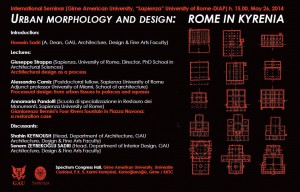
ISUF 2015 – International Conference. City as organism: new visions for urban life.
22-26 September 2015.
Faculty of Architecture, ‘Sapienza’ University of Rome, Rome, Italy
Call for papers (deadline 15 January 2015)
Conceptions of the city have changed significantly in recent years. The character of major infrastructural, residential, commercial and manufacturing developments suggests that current challenges may be a great deal more than a blip in the course of history. Some would argue that the dialectic between the desire to restore the organicity of urban form and the incoherent reality of the actual city is at the core of some of the finest projects and plans that have been developed. Is this a line of thought that is practicable in urban morphological research and practice? Or should we accept the incoherence of cities as amalgams of fragments? A central theme of the Conference is the ‘reading’ of existing cities in the light of a possible new organicity, comparing viewpoints from different disciplines; from architecture to history and from geography to urban planning. Discussions will deal with a variety of scales, from the territorial to the urban, and from the entire city and constellations of cities to the scale of the individual building. The Twenty-Second International Seminar on Urban Form (ISUF 2015), hosted in Rome by the Faculty of Architecture of ‘Sapienza’ University, will take place in Valle Giulia, via Antonio Gramsci 53, 00197, Rome, Italy, from 22 to 26 September 2015. The theme of the conference is ‘City as organism: new visions for urban life’. Scales and topics to be covered include:
Territorial scale
New and historical landscapes
Infrastructural networks
Territorial geography
Urban organism scale
Urban growth and fringe belts
Contemporary design for historical cities
Urban aesthetics and new tendencies in urban design
Eco-cities
Urban fabric scale
Urban morphology and urban regeneration
Reading and designing urban fabric
Urban form and meaning
Urban knots
Building scale
New design methodologies
Architectural heritage preservation methods
Modern legacies
Modern constructions and Mediterranean identity
The organizers and the Council of ISUF invite participation by interested academics and professionals. Proposals for papers should take the form of abstracts of papers. They should be prepared in the following format: title of paper, author(s) name, affiliation, full postal address, e-mail address, telephone number, 3-5 key words, conference topic/scale and a 250-word abstract, in a MS Word file (.doc) using the abstract template available on the website (font: Times New Roman). Proposals should be uploaded on the conference site after registration. Abstracts of papers must be received before 15 January 2015. Notification of whether abstracts have been accepted will be provided by 1 March 2015. Those whose abstracts have been accepted will be required to pay a registration fee by 15 May 2015 to have their papers included in the conference programme. The registration fee of €300 (students: €200) includes 12 months’ membership of ISUF and 3 issues of the journal Urban Morphology, conference cocktail, coffee breaks and gala dinner. Following acceptance of abstracts, submission of papers (not exceeding 4000 words) is required. They should be received by 30 May 2015. Authors should consult the notes for the guidance of contributors to Urban Morphology, available on the ISUF website (http://www.urbanform.org), or in recent copies of that journal, before preparing their papers. Selected papers may be published after the conference. The official conference language is English. There will be a New Researchers’ Forum, in which researchers new to the field are invited to take part. New researchers should indicate when they submit their abstracts whether they would like to be included in the New Researchers’ Forum. Post-conference excursions will take place in Rome, Hadrian’s Villa, (Tivoli) and to the historical town of Todi.
The Conference Scientific Committee comprises:
Giancarlo Cataldi (University of Florence, Italy), Michael Conzen (University of Chicago, USA), Kai Gu (University of Auckland, New Zealand), Ivor Samuels (ISUF, UK), Jean-Francois Lejeune (University of Miami, USA), Renato Masiani (“Sapienza” University of Rome, Italy), Vítor Oliveira (University of Oporto, Portugal), Piero Ostilio Rossi (“Sapienza” University of Rome, Italy), Jeremy Whitehand (University of Birmingham, UK).
The Conference Organizing Committee comprises:
Giuseppe Strappa, Chair (‘Sapienza’ University of Rome, Italy), Alessandro Camiz (‘Sapienza’ University of Rome, Italy), Paolo Carlotti (‘Sapienza’ University of Rome, Italy), Anna Irene del Monaco (‘Sapienza’ University of Rome, Italy), Matteo Ieva (Politechnic of Bari, Italy), Marco Maretto (University of Parma, Italy), Nicola Marzot (University of Ferrara, Italy, and TU-Delft, The Netherlands), Dina Nencini (‘Sapienza’ University of Rome, Italy), Fabrizio Toppetti (‘Sapienza’ University of Rome, Italy).
All ISUF regional groups will be invited to organize a session, a poster or a seminar:
Each ongoing ISUF Task Force will be invited to present its work. http://www.urbanform.org
The conference website, providing more detailed information, is
http://rome2015.isufitaly.com
Enquiries and suggestions concerning the conference should be forwarded to
info.rome2015@isufitaly.com










